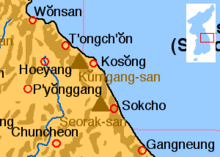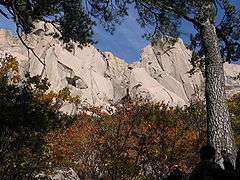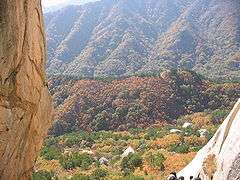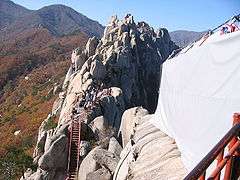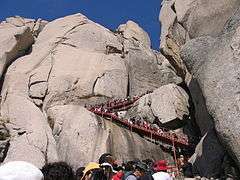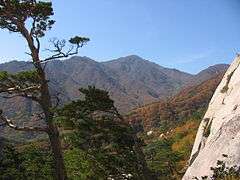Seoraksan National Park
Seoraksan National Park (Korean: 설악산국립공원, 雪嶽山國立公園; RR: seoraksan-gungnipgong-won) is a national park in South Korea. It listed by the South Korean government with UNESCO as a tentative World Heritage site. The government designated the area as a nature reserve in 1965 and UNESCO designated it as a biosphere reserve in 1982. It was also the first Korean national park to be named under the National Park Law in 1970. Located on the east-central Korean peninsula, the reserve includes the Dinosaur Ridge, Injegun, Yanyanggun, and Sokchosi. It is popular with tourists and nature enthusiasts. It is home to many rare taxa of flora and fauna.
| Seoraksan National Park | |
|---|---|
| 설악산국립공원, 雪嶽山國立公園 | |
IUCN category II (national park) | |
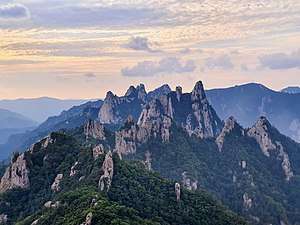 The Dinosaur Ridge at Seoraksan | |
| Location | South Korea |
| Coordinates | 38°07′30″N 128°24′58″E[1] |
| Area | 398.22 km2 (153.75 sq mi) |
| Established | 24 March 1970 |
| Governing body | Korea National Park Service |
| Seoraksan National Park | |
| Hangul | |
|---|---|
| Hanja | |
| Revised Romanization | Seoraksan Cheonyeon Boho Guyeok |
| McCune–Reischauer | Sŏraksan Ch'ŏnyŏn Poho Kuyŏk |
The reserve has an area of 163.6 square kilometres (63.2 sq mi) and includes many mountain peaks measuring over 1,200 metres above sea level, the tallest being Daecheongbong, at an altitude of 1,708 metres (5,604 ft). The ranges are composed largely of dissected granite and gneiss. The annual precipitation is about 1,000 mm (39 inches) in Inner Soraksan and 1,300 mm (51 inches) in Outer Soraksan.[2]
The park is valued for its floral diversity. There are about 1,013 species of plants known, with 822 vascular plant species. Pine trees such as the Siberian pine are abundant on the southern slope while the northern slopes of the mountain range are characterized by oaks and other deciduous trees. Thuja grow in the deep valleys. Dwarf pines and yews grow on low and high slopes. Juniper, hawthorn, and Manchurian fir can be found. Other plants include forsythias and saw-worts. Rare plants in the reserve include Hanabusaya asiatica.

Land-based parks are in red and marine parks are in blue.
1,562 animal species have been classified so far. Local fauna include otters, Siberian flying squirrel, kestrel, Chinese sparrowhawk, lenok, Chinese minnow, and spotted barbel. Endangered animal taxa include Tristram's woodpecker, Korean goral, and Korean musk deer.
Cultural landmarks in the reserve include the Buddhist temples Baekdamsa and Sinheungsa.
Gallery
See also
References
- Seoraksan National Park protectedplanet.net
- Cultural Heritage Administration of Korea (Korean)
External links
| Wikimedia Commons has media related to Seoraksan. |
- Seoraksan. Korea National Park Service.
- UNESCO
- World Heritage in Korea (pdf)
